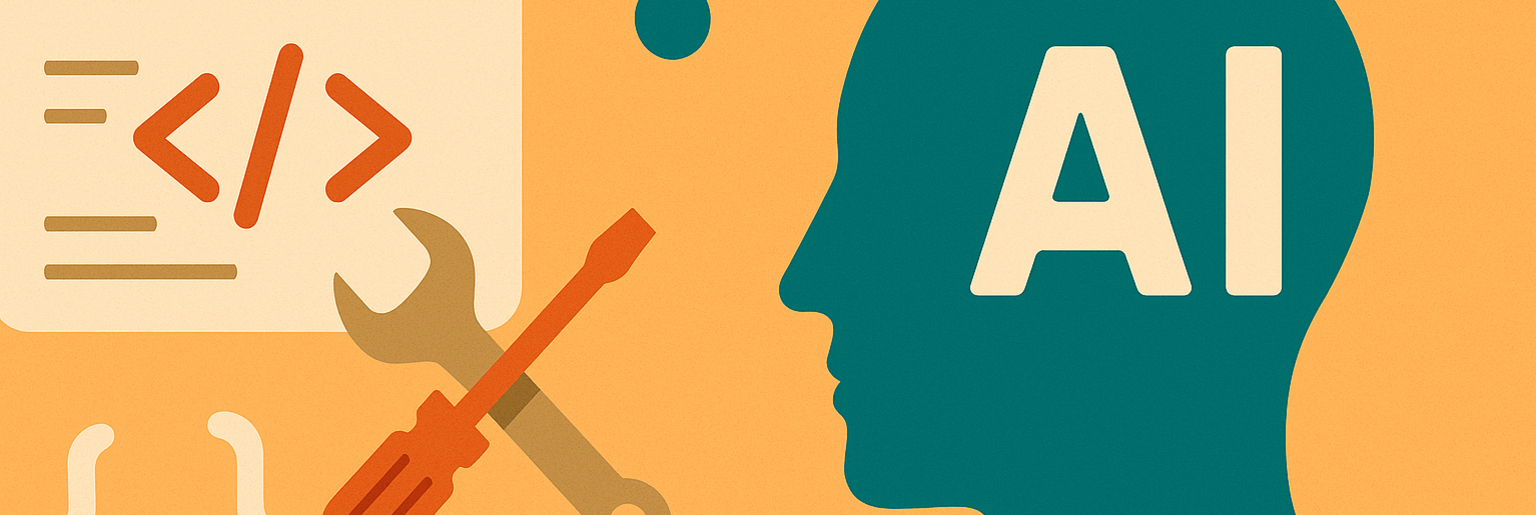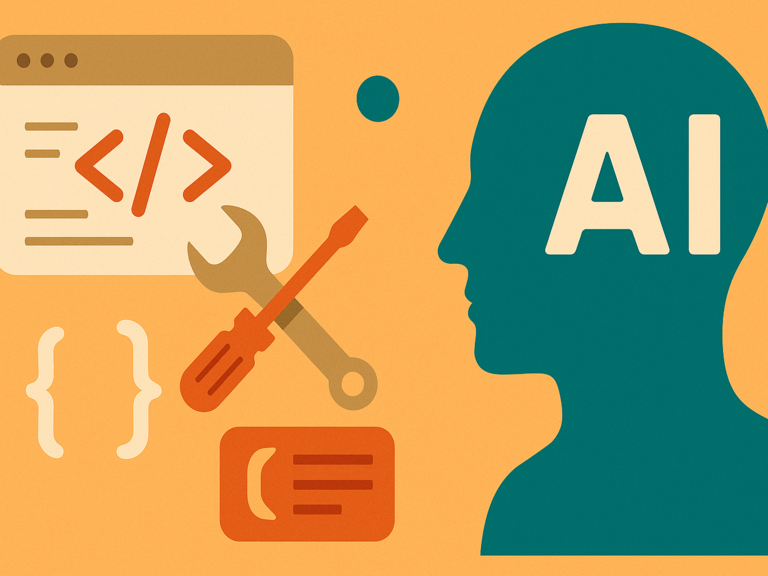1 Comment // Reading Time: 9 min.
Welcome back to our AI article series!
This article is part of our comprehensive AI article series, in which we compare practical AI tools for various digital tasks, including research, text generation, image generation, video generation, and language processing.
We are now focusing on AI tools for software development. The variety of coding tools is so vast that we have divided the comparison into four articles:
- Auto-complete & IDE integration
- Web and cloud coding environments
- Dialog-based assistants for programming (which we will discuss in this article)
- Pair programming & explanatory AI
This third part focuses on dialogue-based AI tools that provide programming support via chat interaction. Unlike pure code completion, these assistants offer context-sensitive help with debugging, explaining, refactoring, and planning code. Some work entirely in the browser, while others are deeply integrated into IDEs.
The selection includes both universal tools such as ChatGPT, which can perform a wide range of tasks, and specialized IDE assistants such as Cursor or Continue – supplemented by Grok, which was developed in the X ecosystem (formerly Twitter) for developer interaction. The aim of this article is to compare the strengths, limitations, and areas of application of these tools – with clear recommendations for different types of users.
ChatGPT
Universal AI chat with strong coding support, broad knowledge, and web app
- Very flexible, many models
- Diverse functions (chat, analysis, debugging)
- Extensive world knowledge & custom GPTs
- No real IDE access
- Limited project context
- Data processing in the cloud
Cursor
AI editor optimized specifically for software development with GPT integration
- Deep IDE integration (code completion + chat)
- Project context across many files
- Refactoring, testing, documentation, and more
- Only usable with an account
- Some features require payment
- No offline mode
Continue
Open-source AI for IDEs with a focus on data protection and local use
- Local operation possible (self-hosted)
- Model-free & flexibly configurable
- No cloud requirement
- Technical know-how required
- Less OOTB convenience
- No dedicated hosting service
Grok
AI assistant in the X universe (formerly Twitter), experimental for developers & platform support
- Direct reference to platform data (e.g., repos, threads)
- Deeply integrated into X for the long term
- Chat-based problem solving
- No IDE access
- Focus on X environment
- Early phase
- Provider (year of release): OpenAI (ChatGPT 2022; GPT-4 released in 2023; GPT-5 officially available from August 2025)
- Free to use: Yes – basic version still available, now with GPT-5 (limited use possible – free users are redirected to GPT-5 Mini when they exceed their limit)
- Account required: Yes – OpenAI account required
- Premium access: ChatGPT Plus (€23/month), Pro (€229/month)
- Models used: GPT-5 (Free, Plus, Pro), with Mini and Nano variants for different speed/cost levels
- Special features: GPT-5 offers a context window of up to 1 million tokens, significantly improved logical thinking, reduced hallucinations, and multimodality (text, image, audio, video).
Who is ChatGPT suitable for?
Perfect for anyone looking for powerful, interactive AI assistance – for code generation, refactoring, debugging, documentation, or complex concept clarification, for example. GPT-5 stands out in particular thanks to its long-term context understanding and its ability to assist with tasks like an intelligent assistant.
Terms of use & tips
Users interact either via the web interface or the API. GPT-5 responds dynamically – for demanding tasks, it automatically uses the powerful version, with Pro accounts receiving unlimited, prioritized access. For robust use, Plus or Pro is recommended to avoid limits.
Data protection & legal aspects
Inputs are processed in the cloud. For sensitive or proprietary applications, we recommend the Pro license with extended control. OpenAI does not regularly use user data for training purposes unless otherwise specified – however, caution is advised when dealing with sensitive content.
Advantages and disadvantages of ChatGPT summarized
|
|
- Provider (year of publication): Anysphere (Cursor AI was released in 2023)
- Free to use: Yes
- Account required: Yes
- Premium access: Approximately $16/month (annual), additional plans: Ultra, Teams, Enterprise
- Models: Cursor supports all Frontier coding models from all major model providers.
- Editing features: Chat interface in IDE, inline completion,
refactor,test,debug,document,comment, project-wide context, AI features such as Bugbot (automated debugging), and optimized refactor/test workflows with an even stronger focus on context across multiple files.
Who is Cursor suitable for?
Cursor is primarily aimed at individual developers, start-ups, and small teams who work closely with their projects and need support directly in the IDE. Cursor is particularly interesting for anyone who wants to use GPT-supported functions such as refactoring, testing, or documentation across projects and with deep integration.
Terms of use & tips
Cursor is delivered as a separate IDE (fork of VS Code) and integrates seamlessly into the development process. Commands such as refactor, test, explain oder debug can be applied to any code section via a chat sidebar or shortcut – even across multiple files. Thanks to persistent project context, Cursor provides highly accurate answers that are highly relevant to the current project.
Legal aspects & data protection
Data processing is carried out via OpenAI. Project content is processed to generate responses, but according to the provider, it is not used for model training. Anyone processing data-sensitive information should use the enterprise version with local deployment and governance functions.
Advantages and disadvantages of cursors summarized
|
|
- Provider (year of release): Continue Dev, Inc. (2023)
- Free to use: Yes – Open source (Apache 2.0)
- Account required: No – works locally or via API without registration
- Premium access: Team plan ($10/month per developer), other plans: Enterprise
- Models used: many models from major providers, selectable via API key integration
- Editing functions: code completion, chat, edit commands (refactor, explain, document), test generation, agent logic via proprietary agent hub: allows configuration of models, rules, prompts, and actions (e.g., chat, autocomplete, edit, agent) – completely local or optionally cloud-based
Who is Continue suitable for?
Continue richtet sich an Entwickler:innen, die maximale Kontrolle und lokale Verarbeitung schätzen. Besonders geeignet ist das Tool für Open-Source-affine Nutzer:innen, die ihre Coding-Workflows mit KI anpassen oder erweitern möchten – ohne sich an ein proprietäres System zu binden.
Terms of use & tips
Continue läuft als Erweiterung in VS Code oder JetBrains IDEs und bietet direkt im Editor Zugriff auf kontextbezogene KI-Funktionen. Nutzer:innen können über API-Keys verschiedene Modelle einbinden, eigene Agenten definieren oder Regeln festlegen. Die Integration erfolgt vollständig lokal oder optional cloudbasiert.
Legal aspects & data protection
Local execution enables data protection-friendly working, as no code is automatically sent to external servers. When using external APIs such as OpenAI, the user or team is responsible for complying with the relevant data protection regulations (e.g., GDPR). The open source license (Apache 2.0) allows for flexible reuse.
Advantages and disadvantages of Continue summarized
|
|
- Provider (year of release): xAI, founded by Elon Musk (chatbot release November 2023); current top model Grok 4 (released July 2025)
- Free to use: Yes – basic features available free of charge via platforms such as X, grok.com, or app
- Account required: Yes – e.g., X account for use on the platform or iOS/Android apps
- Premium access: SuperGrok ($30/month) with DeepSearch, advanced reasoning features, and unlimited image generation; SuperGrok Heavy ($300/month) with maximum computing power, multi-agent features, and API access.
- Models used: proprietary xAI models with multimodality (text, code, image) and Aurora/Flux for image and video generation; supports real-time web search and ‘Think’ mode for complex problem solving
- Editing features: Chat interaction for coding, debugging, and problem solving, including native tool usage; Grok Imagine enables images and short videos from text/voice prompts (including ‘Spicy Mode’).
Who is Grok suitable for?
Grok is suitable for developers looking for dialogue-oriented AI with real-time access to web information – especially within the X ecosystem or mobile usage contexts. Thanks to its large context window and multimodality (Grok 4+), Grok is also suitable as a support tool for code generation and problem solving.
Terms of use & tips
Grok is available via X, grok.com, and as an iOS and Android app. In the current version, Grok 4, the assistant offers multimodality in addition to classic text processing: images can be uploaded or generated (supported by Aurora/Flux). With Grok Imagine, images and short videos can also be created from text or voice prompts – including the popular ‘Spicy Mode’. The assistant is characterised by an often humorous, sometimes provocative style, which is considered entertaining by the community but should be used with caution in professional contexts. Beyond the creative possibilities, developers benefit from real-time search on the web and on X, which is particularly helpful for current platform topics or repository queries. With the announced version Grok 5 and planned variants such as ‘Grok 4 Code’, greater integration into coding workflows is also expected.
Data protection & legal aspects
Grok processes input via xAI servers; data policies are subject to the xAI platform and X. Following incidents involving offensive content (e.g., pro-Hitler statements), moderation has been tightened. Microsoft has so far been cautious in its testing of Grok 4 before planning broader enterprise use.
Advantages and disadvantages of Grok summarized
|
|
Dialog-based assistants such as ChatGPT, Cursor, Continue, and Grok offer an interactive way to write, revise, and better understand code. Depending on their focus and infrastructure, there are significant differences in their suitability:
ChatGPT is suitable for general support, quick brainstorming, and complex analyses.
For working directly in the IDE with a strong project context, Cursor is one of the most feature-rich solutions.
Continue impresses with open-source flexibility and the ability to integrate your own models – ideal for locally oriented developers with technical ambitions.
Grok, on the other hand, scores points with its web connectivity and experimental style, but is (still) less deeply integrated into IDEs and seems more like an experimental companion for creative applications.
The choice of the right assistant therefore depends on whether the focus is on IDE integration, local processing, real-time access to web knowledge, or high language intelligence.
Outlook
In the next and final article in our four-part AI & Coding series, we will focus on tools that simulate pair programming, explain code, provide help with error messages, or automatically generate tests and documentation – including Junie, Cody (Sourcegraph), Tabnine Chat and Codeium.
These solutions offer more than just completion; they represent genuine interaction – with the aim of accelerating, documenting, and improving development.






Comments
Stefan Galinski 196
at 02.11.2025Sehr informativer Artikel. Danke Veronika! Sehr informativer Artikel. Danke Veronika!